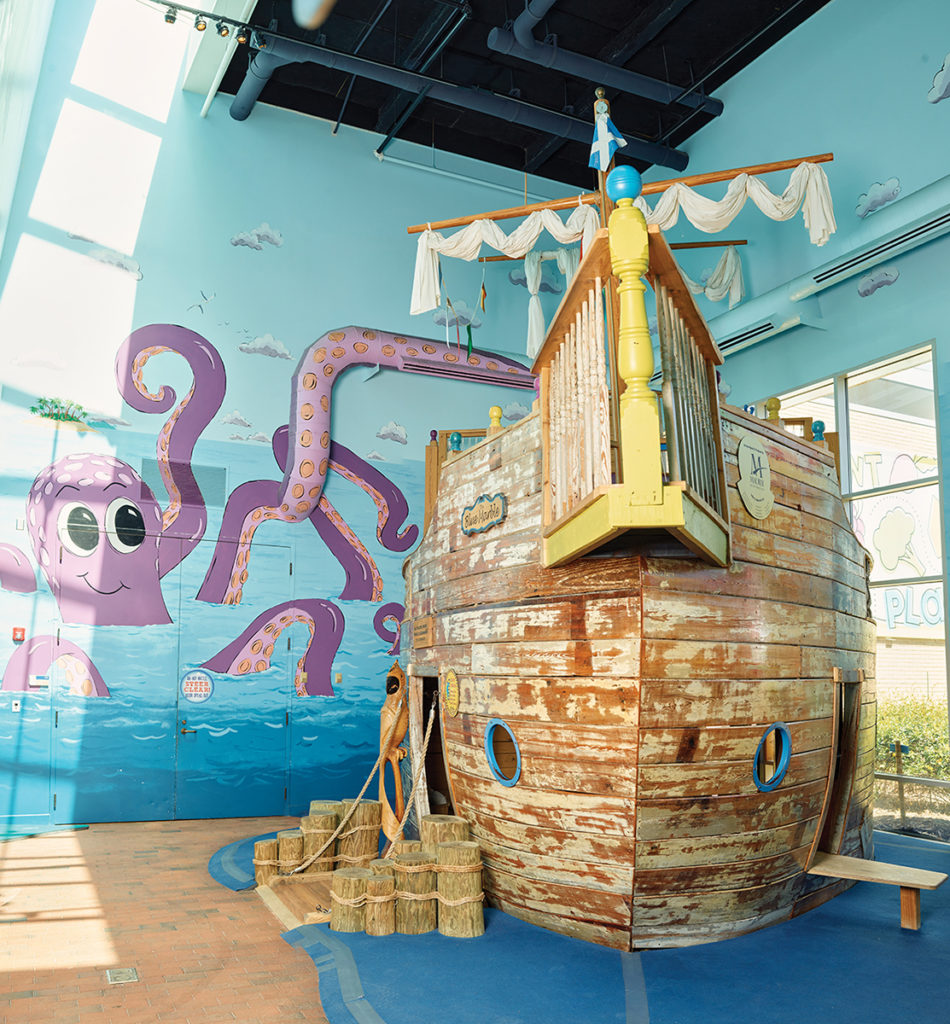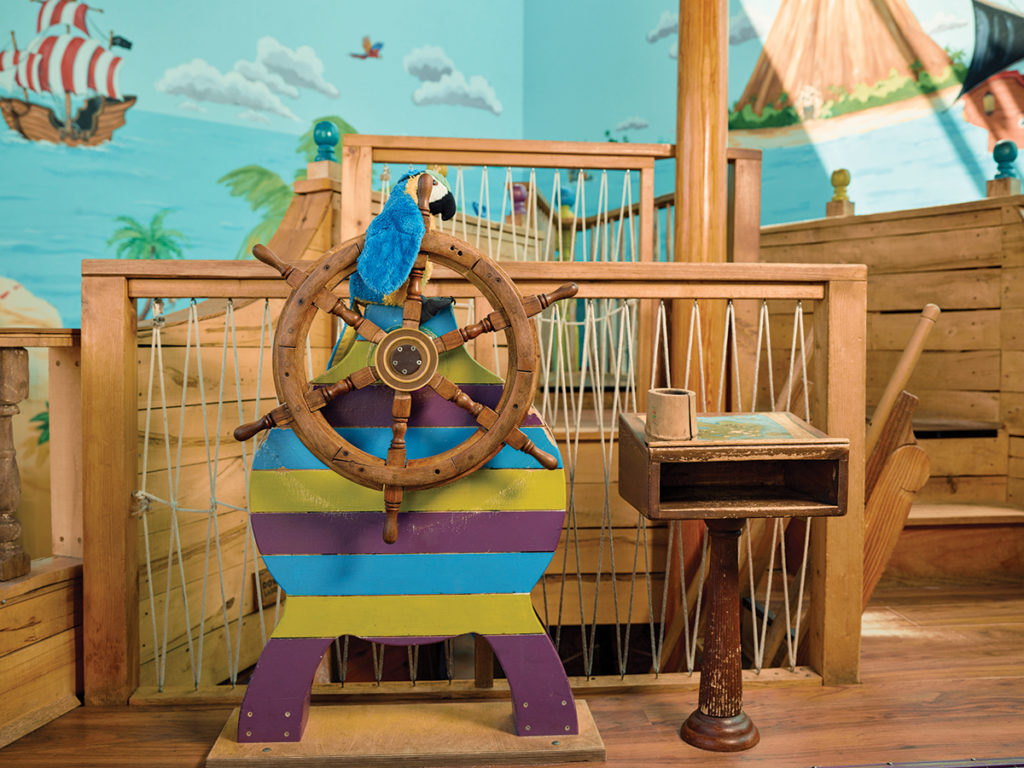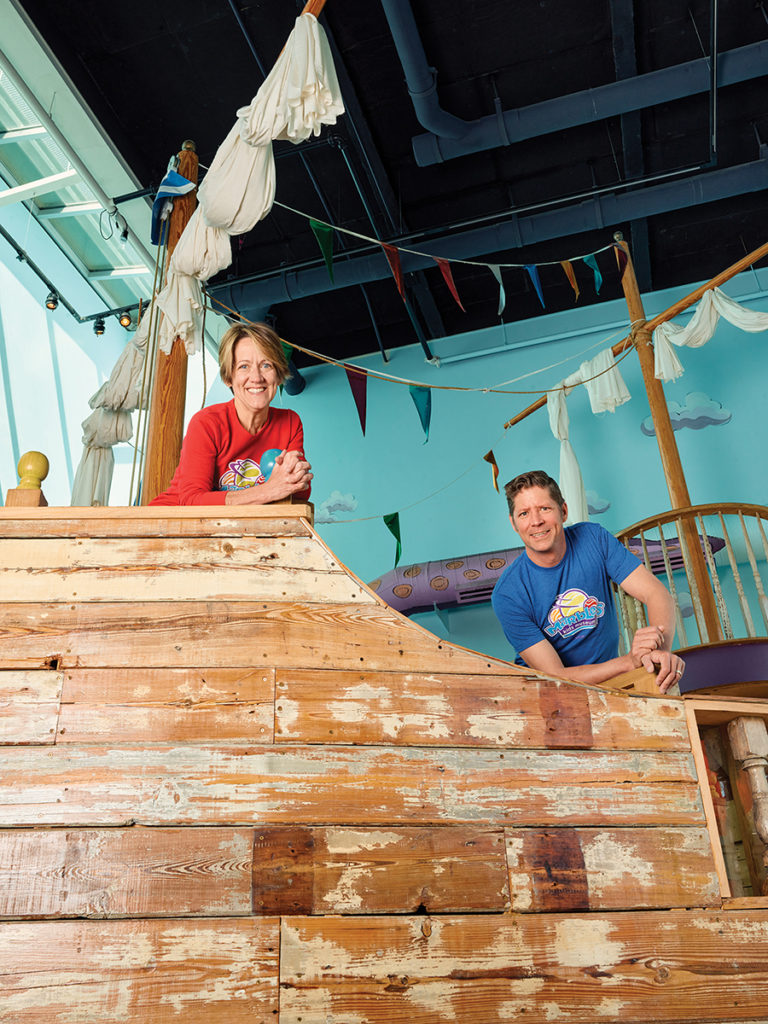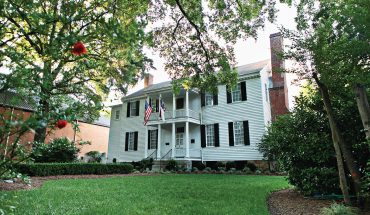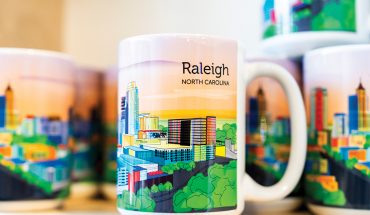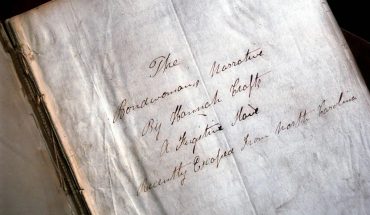Fifteen years in, a scaled-down ship built through a community effort is a place for kids to play and learn.
by Hampton Williams Hofer | photography by Joshua Steadman
At 3:30 a.m. on Sept. 29, 2007, Marbles CEO Sally Edwards stood at the bow of a three-story wooden pirate ship and painted the finial knob bright blue, a finishing touch on the feature exhibit of the then brand- new Marbles Kids Museum. Just hours later, Marbles would open its doors for the first time to the Raleigh community. Leadership of the new museum — the successor to Exploris and Playspace — sought a signature, one-of-a-kind piece to set the tone for what they knew Marbles could become: one of the most visited children’s museums in the country. That initial piece was a pirate ship known as The Blue Marble.
Today, the ship is approaching its 15th birthday and remains a somewhat hidden gem in the vast landscape of children’s dream-makers at Marbles (you’ll have to get the kids past the school bus, fire truck, farm and submarine to get to it). As summer approaches, with both boats and cooler indoor play alternatives on the mind, the pirate ship is the spot. And it has a surprising origin story.
With a shoestring budget and a nearly impossible timeline of only 24 days, local volunteer architects, welders, and carpenters collaborated to create this wooden ship that lives on the first floor. Chris Alexander, director of exhibits at Marbles, recalls the ship’s formation: “In an area of the museum where we were retaining some water-themed components, we thought, with North Carolina’s rich history with pirates, why not a pirate ship?” he says, a nod to one of the most notorious pirates, Blackbeard, along with his many contemporaries who mauraded the shores from Currituck to Cape Fear. “We knew the design and construction would be formidable, but our community was stepping up in amazing ways to help create Marbles. It truly was an ‘all hands on deck’ undertaking.”
Across the building that had once been Exploris Museum and School, numerous designers and builders who normally competed were working together to bring Marbles Kids Museum to life. For the pirate ship, the star was David Maurer, president of Maurer Architecture, who led the effort to create a site-specific, realistic pirate ship that met both programmatic needs and building codes. “We jumped at the chance to make a mark at the emerging new children’s museum. It took our entire firm to bring the pirate ship to life, with late nights and weekends and calling in favors,” recalls Maurer, who became its Noah, working relentlessly with his team to complete the ship before the visitors flooded Marbles. “Looking back, it was a cool opportunity to exercise our creativity in a playful way and to get to design and build something one-of-a- kind. The ship’s lasting popularity and durability are testament to the many caring hands involved in its creation.”
Wake County contributed pecan boards milled from trees downed at the Historic Oak View County Park during Hurricane Fran. That wood forms the interior of the ship, where children unknowingly run their fingers along the history of this city. Maurer’s team sourced reclaimed materials for the hull, and North Carolina Maritime Museums built and donated the masts. Sedaris Hardwood Floors stepped in to lay the decking, and carpenters from renovators Barnhill Contracting Company helped finish the ship on time.
Edwards has since spent many more late nights perfecting new exhibits, but the pirate ship stands out. “Coming on board in 2007 to lead a merger and create a new children’s museum was an exciting career adventure, albeit a risky one. Back then, the pirate ship project mirrored that risk and adventure,” she says. “Today, it symbolizes all that Marbles means to me — dreaming big, playing bold, and teaming up to rally past perceived limits of creativity and resources.” The pirate ship set a standard for Marbles’ signature kid-scale environments like its popular fire truck and grocery store. For Alexander, it was his first chance to utilize his skills on an original exhibit: “The pirate ship really helped set Marbles apart in the beginning and laid the groundwork for how we would continue to think big and bold.”
The pirate ship doesn’t just look really cool: it is a hotbed for learning. Children duck into its underbelly and climb the ladders, learning safe-risk and motor skills. “Witnessing the joyful pride of a child who overcomes fear to reach the crow’s nest is a deeply special, almost spiritual moment, every single time,” says Edwards. “Waiting for a chance to swing in the captain’s hammock fosters critical social and emotional skills like recognizing and managing emotions, negotiating, taking others’ perspective, delaying gratification, reading social cues, taking turns and sharing.”
Marbles leadership taps into research from an educator advisory board and content experts to create richly layered and everevolving experiences. “Every exhibit is intentionally designed to foster early childhood learning and development through play,” says Edwards, who’s set to retire at the end of this month. Over her tenure, Marbles has earned numerous awards and recognitions, garnering a spot as the sixth most visited attraction in all of North Carolina. The museum has grown and added new, upgraded exhibits, but there in the back corner of the first floor, the pirate ship remains, with children shouting arg! and ahoy! as they lean over the blue finial that still sits boldly on the bow.
So many minds and hands from all over the community, recognizing the power of play, came together to create a pinnacle of Marbles that has stood the test of time. “Ultimately, the pirate ship contributed to building the culture of creativity, teamwork, and community engagement that still drives us today,” says Alexander.
__
This article originally appeared in the June 2022 issue of WALTER Magazine.

